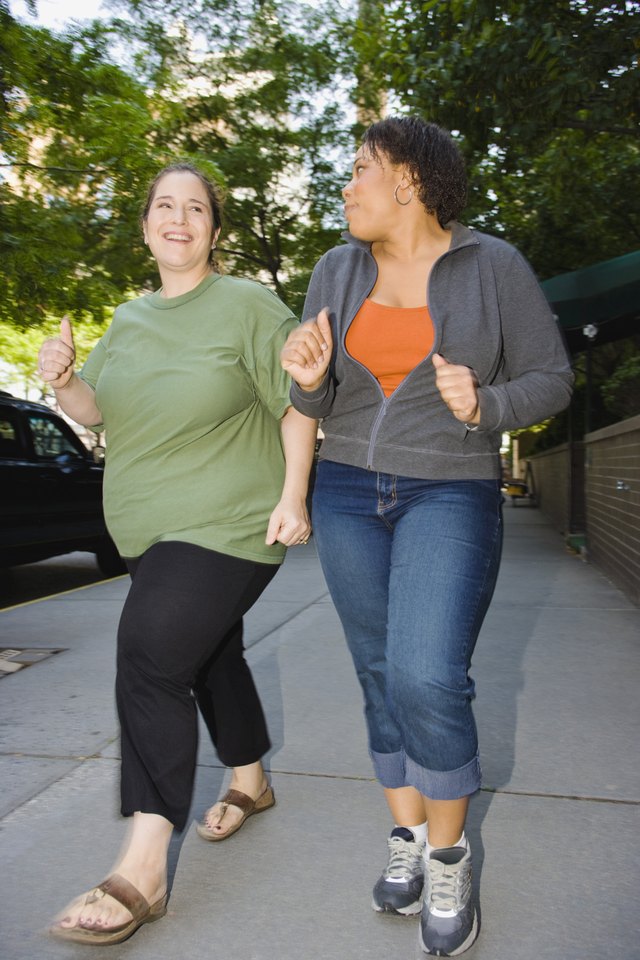Is Exercising in 10-Minute Increments Just as Effective as Longer Periods?

You know exercise is a must in managing your weight, keeping you safe from chronic disease and reducing stress, but fitting it in is a challenge. With school, work, kids, spouse, chores and the occasional fun, time is at a premium. Fitting in 30 minutes of exercise daily may simply not be realistic. Stressing about not getting to the gym only adds pressure to an already full schedule. For general health, you can break that 30 minutes up into more manageable 10-minute blocks and still reap enormous benefits.
Recommendations
The Centers for Disease Control and Prevention says adults need a minimum of 150 minutes per week of moderate-intensity aerobic exercise weekly, or about five 30-minute sessions per week. Doing more than this will most likely provide greater benefits and possibly lead to significant weight loss if paired with a low-calorie, portion-controlled eating plan. Moderate-intensity exercise includes brisk walking, heavy gardening and playing doubles tennis. If you exercise at a vigorous rate, such as running or jumping rope, you can get away with just 75 minutes per week. You should also strive to do two total-body strength-training sessions weekly that engage all the major muscle groups with at least one set of eight to 12 repetitions with weights heavy enough to fatigue you by the last few lifts.
Research
A landmark study published in 2001 in the “Journal of the American College of Nutrition” concluded that short, 10-minute bouts of exercise had a similar effect as one long session when it comes to aerobic fitness and weight loss. Among the study's overweight, college-age women, oxygen use improved, and weight, body mass index and body fat decreased in groups that spent 30-minute sessions exercising, and in groups that broke the 30 minutes into 10-minute segments throughout the day. Participants all exercised at the same intensity during their exercise sessions -- about 75 percent of heart rate maximum -- and followed a calorie-restricted diet for the 12 weeks.
Breaking Up Cardio
Doing all 150 minutes, or 75 minutes of more intense exercise, in one day is not recommended. Break it up over the course of the week, says the CDC. When you break it up even further -- into 10-minute chunks throughout the day -- the 150-minute target seems doable. Try adding a 10-minute walk before you hit the morning shower. Add another 10 minutes of walking around your office building or outdoors at lunchtime. After dinner, head out for one more 10-minute walk with your family or a friend. You can also break up the strength training into 10-minute intervals.
Strength Training Sessions
A total-body session usually takes between 20 and 30 minutes, but you can break these into 10-minute sessions. You want to leave about 48 hours between strength-training exercises for specific body parts to allow for rest and recovery. Maybe in the morning you do a 10-minute squat, lunge and crunch workout, and in the evening do 10 minutes of pushups, dips, bicep curls and shoulder presses. You could also break up the strength training over several days. For example, Monday and Wednesday might feature 10 minutes of lower body exercises, while Tuesday and Thursday involve 10 minutes of upper body exercises.
Considerations
If you are training for a sport or event such as a 5K, you will benefit from longer training sessions. While 10-minute bouts of exercise can improve fitness and health, they will not build stamina and endurance as well as longer sessions. Before committing to any athletic endeavor, figure out when you can fit in time for training. Entering these events without preparation only invites injury and frustration.
References
- Centers for Disease Control and Prevention: How Much Physical Activity Do Adults Need?
- USA Today: How to Drop Pounds with All-Day Activities, Not Exercise
- The New York Times: It’s Time for Recess: Just Keep on Moving
- Journal of the American College of Nutrition: Effects of Long versus Short Bout Exercise on Fitness and Weight Loss in Overweight Females
Writer Bio
Andrea Cespedes is a professionally trained chef who has focused studies in nutrition. With more than 20 years of experience in the fitness industry, she coaches cycling and running and teaches Pilates and yoga. She is an American Council on Exercise-certified personal trainer, RYT-200 and has degrees from Princeton and Columbia University.
